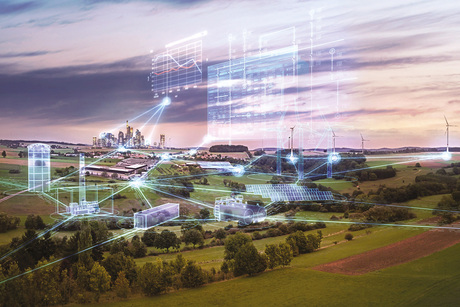Distributed Energy Systems (DES)

Global energy consumption has grown steadily over the past century. This trend, driven by population and economic growth, is set to continue in spite of rising efficiency of both production and consumption. The IEA estimates that over the period to 2035 the investment required each year to supply the world’s energy needs will rise steadily to $2000 billion.
In response to new opportunities such as renewable energy and smart technologies — and new policy goals — to reduce emissions and extend energy access, Distributed Energy Systems (DES) encompasses a diverse array of generation, storage, energy monitoring and control solutions. DES technologies represent a paradigm shift and offer building owners and energy consumers significant opportunities to reduce cost, improve reliability and secure additional revenue through on-site generation and dynamic load management.
The numbers speak for themselves. Operational cost reductions ranging between 8% and 28% and a return on investment (ROI) between 3–7 years compared to a business as usual are observed. CO2 emissions are reduced at similar scales, with wider uptake delivering significant economic, social and environmental co-benefits through better system resilience and efficiency, including lower cost grid balancing, reduced greenhouse gas emissions and affordable extension of grids to unconnected communities.
Improving Security of Energy Supply & Resilience
Energy infrastructure all over the world is ageing and requires significant investment to replace and repair. The risks associated with such ageing assets coupled with shocks derived from large scale weather related events could lead to potential failures in the network or poor environmental compliance.
Local, decentralised and controllable DES generation and storage sources can be designed to provide the end user with local resilience or even full independence from the grid. The benefits accrue to grid operators as well: DES can manage demand to reduce peak loads when infrastructure is nearing capacity, thus postponing the need for major grid reinforcement investments.
Energy Cost Reduction
Low but uncertain oil prices not only make overall energy costs unpredictable but increase risk on large investments in energy system upgrades, potentially obstructing the requirements of the end consumer. DES can be customised to match the consumer’s requirements as well as enabling actors to shape local generation and consumption in response to market price signals to achieve the lowest overall cost of energy.
Low Carbon Energy and Energy Efficiency
DES includes renewable and low carbon generation and controls that enable the integration of such technologies into the network and as a result reduces the carbon intensity and impact on the local environment of the energy system.
At a local level, poor air quality can proliferate acute public health problems. DES that rely on clean energy generation or hybrid systems, have a reduced impact on air quality and help maintain a greener and cleaner ecosystem.
DES coupled with other traditional energy conservation measures can improve efficiency across the energy system. Integrated real time data monitoring and multipoint controls at both plant, building and network level can improve asset utilisation and plant efficiency and ensure power, cooling, heating and lighting are used only when and where they are needed.
Access to Energy for All
The IEA estimates that 1.2 billion people, around 17% of the world’s population, have no or very limited access to electricity with the majority of this population located in Sub-Saharan Africa and East Asia. Smaller scale electrification projects based on DES and in particular off-grid microgrids can be implemented quicker and cheaper than major power infrastructure projects as there are fewer planning and regulatory constraints. DES offers the opportunity to provide clean, reliable energy to off-grid communities improving the quality of life and the economic development.
Delivery of Distributed Energy Systems
The emergence of new technologies presents an opportunity to develop tailored financial instruments and ownership models which can stimulate the uptake while absorbing some of the inherent risk.
DES financial models account for the current trends around outsourcing non-core processes and looking for ways to fund retrofits and upgrades off-balance sheets.
New ownership models have also emerged to address the initial CAPEX costs and the DES plant operation and maintenance. Energy Performance Contracts (EPCs) providers commit to improve the energy efficiency in buildings as an off-balance sheet cost for the owner. Energy cost savings, achieved through the reduction in energy consumption, are used to pay for the installed equipment, with the residual savings shared by the solution provider and the building owner.
Developers are also able to offer full turnkey solutions on DES projects depending on the end user requirements, capabilities and risk appetite. Through a Power Purchase Agreement (PPA), an external developer designs, delivers and operates a plant, eg, a solar PV farm, at a consumer’s property in exchange for an agreed tariff under which electricity is going to be bought. This enables the consumer to purchase electricity directly from the generator rather than from the utility. Similar services are offered in emerging economies by microgrid developers.
A newer breed of energy services companies (ESCOs) is also evolving, focusing more on innovative financing methods, including off-balance sheet vehicles, delivering cost reduction for clients through managed reduction in energy usage.
Hydropower: redefining the renewable energy landscape
SMEC is advancing hydropower projects globally by utilising innovative designs and technologies...
Australia's industries get behind decarbonisation, but urgent action is needed
National research demonstrates that businesses recognise the importance of net zero emissions but...
Designing Tomorrow's Infrastructure Today: Circular Economy and BIM Collaboration
The construction industry plays a considerable role in global energy consumption and...











